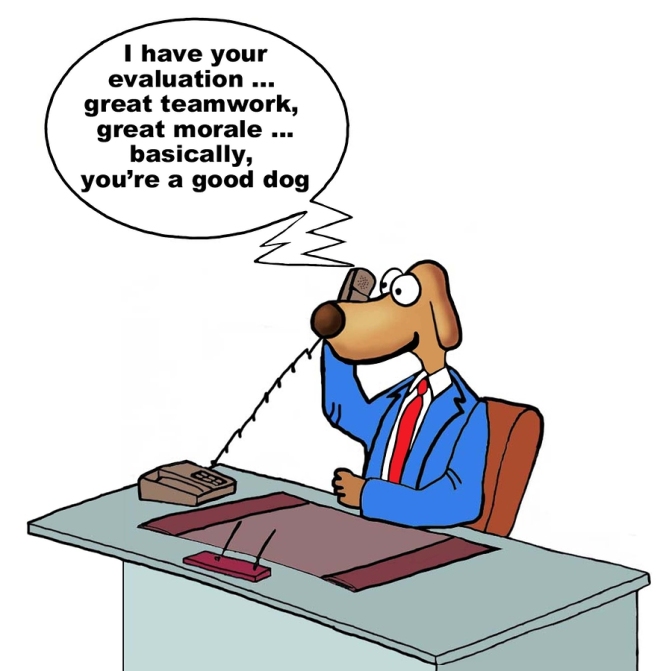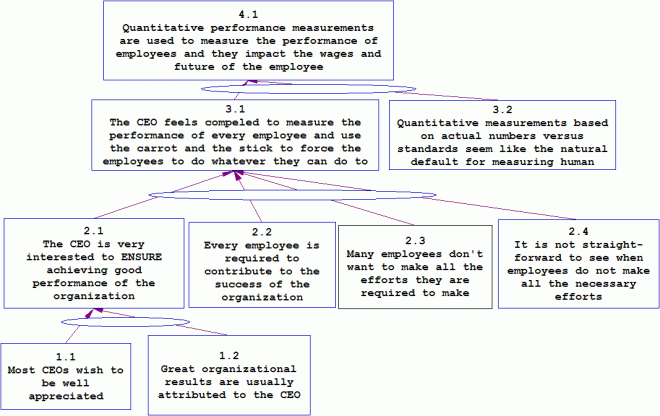“Tell me how you measure me and I’ll tell you how I’ll behave.”
This famous citation states an inherent conflict between the individual and the organization. The individual, according to Goldratt, behaves according to the way he is measured, which is not necessarily to the good of the organization.
Why would an organization measure its employees???
Do you measure the performance of your spouse, children or close friends? You have certain expectations, which are not always met, but do you look for ways to quantify your expectations?
What is the gain from performance measurements?
One real and important gain is to know whether you need to analyze much deeper how come the results deviate from your initial expectations. In order to get that objective you need recorded expectations. Now – expectations are never one clear number – are they?
As a father I expected from my children to achieve good grades from school, say B and above. Getting a low grade did not call for punishment, but we tried to understand the reason and what can be done next time. Other parents push their children much more. Is the push valuable? Certainly, treating the grades as performance measurements that invoke positive and negative reactions would improve the grades. The more important question is: would they improve the life of the children?
Do performance measurements improve performance?
Goldratt has shown us how flawed measurements could reduce global performance. There are three different causes for a performance measurement to radiate the wrong message:
- They are the wrong measurements.
- Dependency – the measurement depends not just on my performance, but also on other factors, like the performance of others.
- Variation. My performance varies. Some of the causes for the variance can be explained by external factors (like headache) and some have no clear explanation.
How significant is the variation factor? I like to watch sport on TV in order to spot the unexplained variation in the performance of the players. It is most noticeable in Tennis how the number of “unforced errors” and the “first serve percentage” fluctuate within one game. It demonstrates that the variation in our ability to do things is quite significant.
When the performance measurements ignore the impact of dependency and variation, the employee distrusts the measurement and is led to do whatever he can to manipulate them to his own sake.
See what we have got so far: ignoring complexity (dependency), ignoring uncertainty (variation) both are direct consequences of lack of trust.
Trust, or the lack of it, is a critical factor in life as well as in business and most certainly in managing organizations. The fact that the organization does not trust its employees and thus uses performance measurements actually causes the employees to distrust their bosses and pushes them to plan carefully their behavior – against the interests of the organization.
It all starts with the relationships between the CEO and the owners (shareholders and possibly the board). Every CEO likes to make sure the organization achieves the results that please the owners and makes him/her a highly appreciated CEO.
An obvious difficulty for the CEO is to make sure all other employees do whatever they need to do to achieve the results. Thus, when possible, they impose performance measurements to push their subordinates to make more efforts. Do they really make more efforts? Or do they just manipulate their available capacity according to the specific measurements and nothing else is important?
A simple cause-and-effect tree to showing the rush for using performance measurement on employees
Is there anything wrong with the above logic?
What do you think of entity 2.3 – is it really valid in reality? Let’s discuss it further to lead us to the direction of a solution.



If I am viewed statistically on my performance and I joined the organisation for their supposed ethos then my needs are not being met. If my needs are not being met and I am afraid I can’t meet with the organisation statistical performance, then I am working towards an unachievable goal. If I am working towards an unachievable goal and I feel frustrated because my gains are not noticed then I will develop a MYAM over time.
Time being operative and I have developed a MYAM time then I become another wheel in a cog, just working enough for my salary.
LikeLike
Carole, I fully agree with your cause-and-effect branch. I also think that even if I did not join the organization because of their ethos, I still had very good intentions to do good. Being measured in a way I feel is distorted would make me frustrated.
By the way, I’m not familiar with the expression ‘MYAM’.
LikeLike
Are there some words missing from entities 3.1 and 3.2?
Entity 2.3 is an interesting one. It might be that employees and the CEO would word it slightly differently or interpret it slightly differently. That is, is it that employees don’t do all that they are REQUIRED to do or that they don’t do all that they COULD do? An employee might say, “I did what I was told (required) to do” because they have so little trust that they will only follow specific orders. The CEO might say, “They could have done this so much better.” And that leads the CEO to the conclusion that his/her directions need to be in the form of specific, detailed orders. That is, micro-management.
I agree with your basic premise that both micro-management and only following orders (or asking permission before any action) come from a lack of trust.
LikeLike
Thank you Steve. You, and also Marjorie Cooper, saw what I failed to see.
The full 3.1 entity is:
The CEO feels compelled to measure the performance of every employee and use the carrot and the stick to force the employees to do whatever they can do to perform well
The full 3.2 is:
Quantitative measurements based on actual numbers versus standards seem like the natural default for measuring human performance
I admit that I might understand the word “required” as expressing what the managers believe the employees should do. The cause I wanted to emphasize is that the CEO wants to ensure his intentions, assuming he verbalized them properly, are carried out and he is concerned that his people might not want to make real efforts to achieve it. This is where the distrust comes in.
I still hope my intentions are clear, even when the verbalization is not perfect.
LikeLike
Thanks for the missing words, Eli. And your point was very clear even without them.
LikeLike
You say “ignoring complexity (dependency), ignoring uncertainty (variation) both are direct consequences of lack of trust”.
I don’t think this is typically the case. I think it’s more likely that management ignores complexity and uncertainty because they either don’t understand them or because they don’t understand how to allow for them in the design of their system of measurements.
I don’t believe that there’s anything inherently wrong with performance measurements. People are naturally productive and will tend to keep track their own performance even if management doesn’t assist them in this endeavor. (Listen to the post-match interviews with the tennis players you cite!)
The problem is that, without management assistance, they are likely to track their performance in a casual mental model that contains the SAME errors for which you are chiding management.
It’s better, IMHO for management to make measurements explicit. And it’s critical that management accommodates the limitations of measurements including complexity and uncertainty–and, including the fact that some performance is unquantifiable (meaning that no one should make any attempt to measure it.)
Employees naturally want to know that they are adding value to the organization for which they work. If management does not publicize a model that explains how the organization works–and how local effort contributes to the global objective–you will inevitably end up with numerous models developed by department heads and individual contributors–and these models will be used as evidence in feuds between team members.
LikeLike
Justin, lack of trust is a consequence of higher level ignoring complexity and uncertainty, so the lower level see the distortion and is pushed to manipulate the measurements.
The higher level management are judged by actual results, which are also a set of measurements, but they also describe the goal. The fear of higher level management is that due to the complexity and uncertainty the results might not be so great – at least for a certain time and the owners might not like it. So, they do two things:
1. They refrain from taking risks, even worthy risks. I have argued about it in the previous post.
2. The put quantitative targets and measurements on the lower levels in order to push them to take all necessary efforts. By doing it they ignore the impact the dependency and variation and cause distrust of the lower level towards the higher level. So, the lower level tries hard to beat the measurements and these actions reduce the global performance.
So, is it possible to have a better way?
Is it possible to run an organization without detailed and quantitative measurements?
You wrote: “It’s better, IMHO for management to make measurements explicit. And it’s critical that management accommodates the limitations of measurements including complexity and uncertainty–and, including the fact that some performance is unquantifiable (meaning that no one should make any attempt to measure it.)
I ask HOW???
LikeLike
Eli
I agree that a bad system of measurement causes a lack of trust–but you have the causal arrow pointing in the other direction in your article! (I suspect it’s just a syntactical error.)
You ask “how”, in response to my claim that …
“It’s better, IMHO for management to make measurements explicit. And it’s critical that management accommodates the limitations of measurements including complexity and uncertainty–and, including the fact that some performance is unquantifiable (meaning that no one should make any attempt to measure it.)”
As you point out, at the executive level, it’s easy to identify measurements that directly reflect achievement of the goal.
But as you dig deeper into the organization, it becomes harder as the complexity of the organization starts wreak havoc with your deterministic model.
My simple answer is that you must build a system of measurements that reflects the uncertainty at each level of the organization. And you must make the uncertainty (or the unknowability) an explicit feature of your system to prevent individuals from creating their own wrong-headed metrics.
In many (perhaps most) cases there is simply no need for an open-ended performance goal. Take the role of Payroll Clerk. In order for this person to service the goal of the organization, they must pay people (with minimal errors) on the second Tuesday of each month. It’s fine for them to pursue zero errors — but only to the extent that it doesn’t interfere with them paying people on the second Tuesday of each month.
That’s as granular as measures need to be IMHO. More granularity will do damage.
In some cases, there should be NO metric. Take the case of a Sales Engineer. This person must operate as a go-between between a salesperson (and their client) and the engineering department–in pursuit of the optimal set of trade-offs.
To attempt to reduce the value that this person adds to a single number (or even a set of numbers) would result in the destruction of information and, consequently, would be wrong-headed and harmful.
Where the system of measurements is concerned, it is of extreme value to make it explicit that this role CANNOT be measured objectively–because if you do not do so, someone, somewhere, will invent a measurement.
So, you need a system of measurements but, I maintain that an essential feature of this system is an explicit statement of what cannot–and therefore should not–be measured.
LikeLike
My understanding is that it is a three-legged stool; decision rights, performance measurement and reward systems. Unless all three are well balanced in an organization, it is difficult to achieve the goal, in this case improving performance. It is important that the input used for performance measurement provides clear line of sight to employee in the sense that he/she should be able determine the contribution that his/her efforts bring. Secondly, the inputs should have as little variability as possible otherwise it adds noise to the input which will not give clear picture of employee’s effort. It is essential to recognize that contribution (to profit) drives the effort. Team assignments further complicates and blur the line of sight as it doesn’t recognize individual contribution as much as team effort. It can give rise to free-rider problem. It is also essential that performance measures are well aligned with organizational goals. Sandbagging the sales, window-dressing portfolio are some of the example of not a very well aligned performance measure. Incentive drives performance. Weather incentive is money, job-satisfaction, job-security, ability to make decision and feel important, all leads to better performance depending on what motives performance.
LikeLike